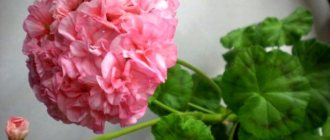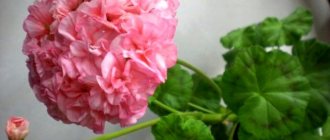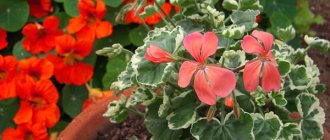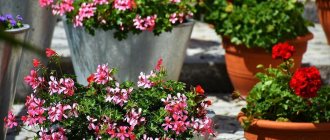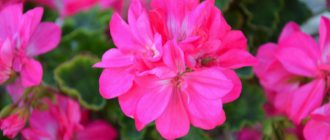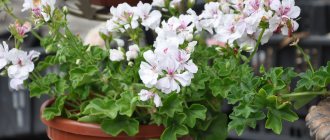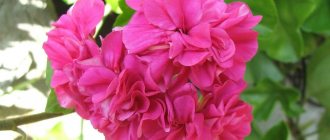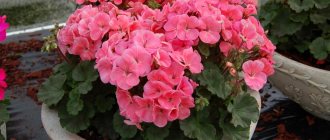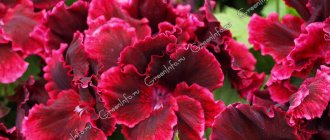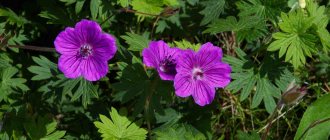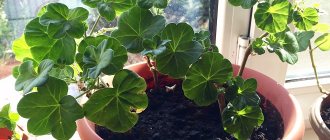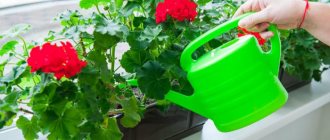Fragrant geranium is an indoor plant that has enormous medicinal and healing potential. Allows you to effectively disinfect a room within a few minutes of being in it.
In this material, we will look at fragrant pelargonium (Pelargonium graveolens) and understand the questions of how to propagate it at home using apical cuttings. It also provides comprehensive information on how to care for fragrant geraniums and what products to use to feed them.
Fragrant geraniums are indoor and garden plants with a bright aroma, and the most striking thing is that not all people find this smell pleasant. He irritates many people.
Unpretentious indoor and outdoor geraniums are herbaceous plants that belong to the geranium family. For a number of reasons, the plant is often called pelargonium. Numerous breeding works have led to the fact that at the moment there are a large variety of indoor and garden varieties. A special place in the list of the most popular plants from private flower collections is occupied by fragrant geranium, which has a bright aroma, expressive appearance, certain medicinal properties and is easy to care for.
See what fragrant geranium looks like in the photos illustrating the magnificent appearance of this crop:
Aroma and properties of geranium oil
To obtain geranium essential oil (aka pelargonium), geranium leaves are first used - it is there that the maximum concentration of components is contained, which gives the essence a tart, sweetish-spicy aroma with bitter notes.
However, in some cases, the entire plant along with flowers is used for production. In perfumery, geranium plays in the “heart” of the aroma composition in both women's and men's perfumes. The fragrant pelargonium of the product lifts your spirits and promotes relaxation. It is effective in combating obsessive fears and anxieties.
Geranium pelargonium leaves are converted into essential oil using steam distillation.
The ether has a number of healing properties, including:
- rejuvenation;
- regeneration;
- antispasmodic effect;
- antifungal and antiparasitic effect;
- increased mental and physical activity;
- normalization of hormonal levels.
Geranium oil also strengthens the immune system, gives a boost of vigor and energy, and helps fight not only age-related changes in the skin, but also treat damage to the dermis.
Propagation of fragrant or fragrant geranium
Pelargonium (geranium) fragrant is a very easy-to-care crop. Even propagating fragrant geraniums is not at all difficult. If you have this perennial in your house and want to get new specimens to put in other rooms or give to a neighbor, then you can start cuttings. Before propagating fragrant geranium, use the apical cuts of shoots to prepare planting material. They can be obtained in the fall, when sanitary pruning of the plant is carried out.
Geranium cuttings are most often rooted in water. Under such conditions, roots will begin to appear in about 15-17 days. Rooting in the substrate also does not take long. To do this, use a soil mixture of peat and river sand. Disinfect the soil before planting. Stick the cuttings at a slight angle to a depth of 2-3 cm and cover with a jar or plastic until roots appear. Some gardeners prefer to root geranium cuttings in a nutrient substrate. The fact is that the plant is afraid of excess moisture and the cuttings can get blackleg. This method of propagation allows you to preserve all the qualities of the mother bush.
Application and benefits of oil
Geranium essential oil is often used in the fight against depression. The product is also recommended for use in order to improve performance. The product is effective for:
- combating self-doubt;
- restoring mental balance;
- adequate assessment of events.
How else can you use pelargonium essential oil? It is used for diseases of the oropharynx, sinuses and ears. It is also used in dental practice. The product not only relieves inflammation, but also eliminates pain. Geranium essential oil is used for fungal skin infections, eczema, burns, dermatitis, neuroses and other diseases.
In everyday life, geranium is used to combat insects, for which the smell of geranium is disgusting. Therefore, pests quickly leave the place where the aroma of the plant is fragrant.
Seed propagation
Seed propagation of geraniums is a very painstaking and time-consuming process. Planting material can be purchased at any flower shop. For propagation, shallow containers filled with an earthen mixture for flowering plants are used. Before sowing, moisten the soil and disinfect it. Spread the planting material over the surface of the soil and cover the container with film; it must be removed after the first shoots appear. You can pick up and plant in permanent places seedlings with 3-4 true leaves.
In spring, you can propagate fragrant geraniums in the simplest way - by dividing the bush. Typically, this method is used for perennial overgrown crops. The plant is dug up or removed from the pot, and the earthen lump is cleaned off (very carefully so as not to touch the buds). The rhizome is divided into divisions so that each of them has several shoots. Treat the cut areas with charcoal and plant in new permanent locations.
Benefits of geranium oil for the body
Pelargonium ether is used in massage mixtures. The procedure helps not only to relax the body, but also to tone the skin. The ether nourishes, softens and improves its elasticity.
In addition, anti-cellulite wraps are made based on the essence. The product is involved in activating blood circulation in problem areas and promotes more active burning of fat deposits - naturally, together with physical activity.
For cuts, burns, frostbite and other skin injuries, it is appropriate to make medicinal compresses with pure pelargonium oil.
Main types
Fragrant pelargonium (Pelargonium graveolens)
This evergreen pubescent shrub is highly branched and can reach a height of 100 centimeters. The green, pubescent leaves are divided into 5–7 lobes and have a very pleasant aroma. The umbrella-shaped inflorescences consist of a large number of pinkish flowers. Blooms throughout the summer.
Pelargonium capitatum
This plant is an evergreen subshrub, the height of which does not exceed 50 centimeters. There is pubescence on the surface of the stems and leaves. Stems are straight. The green, as if crumpled, leaves are divided into 3–5 parts. The inflorescence has the shape of an umbrella. There are many sessile flowers painted in light pink with a purple tint. Flowering occurs from mid to late summer. Has fragrant foliage.
Fragrant pelargonium (Pelargonium odoratissimum)
The foliage of this shrub does not fall off, and its stems are quite short. The rounded, heart-shaped leaves can reach 5 centimeters in width. Their edges are slightly torn, and there are soft short hairs on the surface. The foliage is very fragrant and its smell is quite pleasant. Inflorescences in the form of umbrellas. Whitish-pink flowers are collected in 8–10 pieces.
Pelargonium zonale
These shrubs reach a height of 100 centimeters. There is pubescence on the surface of their fleshy stems. As a rule, the leaf blade is solid, but sometimes slightly lobed. The foliage is green with a brownish border along the edge. The flowers are painted red and collected in multi-flowered inflorescences. Flowering lasts from the end of spring to the beginning of autumn.
Pelargonium cucullatum
The homeland of this evergreen shrub is South Africa. There is pubescence on its surface. The long-petioled leaves are green. The inflorescence is umbrella-shaped and consists of many purple-red flowers. The plant blooms from the end of summer to the beginning of autumn. There are varieties with double foliage.
Pelargonium grandiflorum
This is a highly branched evergreen shrub that can reach 100 centimeters in height. The kidney-shaped, rounded leaves can be either dissected or lobed. They can also be smooth or pubescent. No more than 3 flowers are formed on the peduncle, and they are painted white, and the existing veins are reddish. The diameter of the flowers is 3–4 centimeters. This shrub blooms from mid-spring to early summer.
Pelargonium crispum
This evergreen shrub reaches a height of 50 centimeters and is highly branched. The dense, heart-shaped leaves, growing in 2 rows, have jagged, ragged, wavy edges. Flowering is observed from mid to late summer. 2–3 flowers grow on short stalks. Has fragrant leaves.
Pelargonium inquinans (Pelargonium inquinans)
This shrub, which is evergreen, can reach 1.5 meters in height. Has fleshy stems. The kidney-shaped, rounded leaves are dark green. The inflorescences are umbrella-shaped. Short pedicels. The flowers are red in color. Flowering time depends on care, and can be observed during the summer, autumn, winter or late spring.
Pelargonium crithmifolium
This deciduous plant is a succulent and has thick, creeping stems. The leaf plate is divided into pinnate lobes, the length of which is 8 centimeters. They have a bluish color and can be either pubescent or without pubescence. The inflorescences are presented in the shape of an umbrella. The length of the pedicels is from 15 to 20 millimeters. Snow-white flowers grow in 5 or 6 pieces, and in the throat they have small reddish spots.
Pink pelargonium (Pelargonium radens)
The evergreen, highly branched shrub is pubescent and can reach a height of 50 centimeters. The leaf blade has bilateral pubescence, with hard hairs on the front side and soft hairs on the back. The leaves are quite deeply divided and have curved edges. They are fragrant and have a pleasant aroma. The pubescent peduncle is presented in the shape of an umbrella. Several pink flowers with dark-colored veins grow on the peduncle.
Angular pelargonium (Pelargonium angulosum)
This plant can reach a height of 100 centimeters. The foliage is similar in shape to oak leaves, but the lobes are not straight, but wavy. They are short-petioled. The inflorescence is umbrella-shaped and consists of a large number of flowers, usually colored a rich red color. If you care for the plant correctly, it will bloom from late summer to mid-autumn.
Pelargonium tetragonum
This deciduous shrub can reach 0.6–0.7 meters in height. The tetrahedral straight shoots are pale green, sometimes with a grayish tint. On the surface of the heart-shaped petiole leaves there are sparse hairs. Their width is usually 5 centimeters. The edges of the leaf blade are brownish-red. The flowers have 5 pinkish or cream petals, with 2 smaller petals on the bottom and 3 larger ones on top.
Aromatherapy with geranium oil
Aromatherapy with pelargonium oil has a positive effect on the digestive system, heart and blood vessels. It can be successfully used for such cardiac disorders as:
- arrhythmia;
- tachycardia;
- ischemia.
A positive effect is also observed with high blood pressure.
Inhaling the aroma of geranium will help you overcome attacks of aggression, calm down, get into a working mood and restore your energy. For these purposes, the essence is added to personal aroma pendants, inhaled and added to aroma diffusers.
Simple care for scented geraniums at home
Fragrant geranium at home is one of the easiest plants to care for. But, still, some nuances of caring for fragrant geraniums. Even a very experienced gardener should know this at home. First of all, this concerns the temperature regime. Fragrant geranium does not like to “fry” on sun-drenched southern windowsills; in such conditions, the perennial should be shaded or placed in a room. The optimal temperature in summer for keeping geraniums ranges from +16 to +22 degrees. It is best to place the plant in an east or west window - morning or evening sun hours are beneficial for geraniums.
Caring for fragrant geraniums involves proper organization of watering, since the plant does not tolerate very waterlogged soil. It tends to accumulate moisture in leaf blades and stems and uses water sparingly. Waterlogging of the soil leads to root rot and death of the perennial. It is not recommended to spray the plant due to the large accumulation of glandular hairs on the leaves. If you want to humidify the air, place a container of water next to the pot. You can water the plant only when the top layer of soil dries out.
Before caring for fragrant geraniums, it is worth understanding that complex formulations for houseplants that contain nitrogen, potassium and phosphorus can be used as nutrient fertilizers. It is impossible to overfeed perennials, as this will cause the development of rot. Due to lack of nutrients, the plant becomes dull and leaf turgor is lost. Under no circumstances should geraniums be fertilized with fresh organic matter. Proper care of fragrant geraniums at home allows for rapid growth of the vegetative mass of shoots and vigorous long-term flowering of the plant.
When transplanting young geraniums, you cannot use large pots, as the plant begins to get very sick and loses its decorative effect. It is best if the container is a finger width wider than the root system. In such conditions, geranium blooms very readily. Remember that pots should have strong drainage holes to prevent moisture stagnation. After watering, immediately remove accumulated moisture from the tray. Also, take care of a strong drainage layer of broken brick or expanded clay.
Diseases and pests
Most problems are directly related to violations of the rules for care and cultivation.
Pelargonium is quite resistant to various fungi and viruses. But pests such as aphids and whiteflies often settle on the leaves of the plant.
| Diseases and pests | Cause, symptoms and signs of the disease | Treatment and prevention |
| Gray mold | Cause: excessive soil and air moisture. Symptoms: a gray coating appears on the leaves, stem and trunk. Sometimes pockets of mold look like pieces of grayish cotton wool. | Adjustment of watering, replanting, treatment with Fundazol or Saprol. |
| Violation of planting and care standards | Causes: excessive watering and air humidity. Symptoms are rotting of the root collar, blackening of the lower part of the trunk. | Adjustment of care and elimination of causes. Replanting the plant, removing damaged leaves, stems and peduncles. |
| Reasons: stagnation of moisture at the roots. Symptoms: watery swellings on the leaves. | ||
| Light spots. Cause: sunburn. | ||
| Reason: poor watering. Symptoms: the lower leaves turn yellow and dry out along the edges. | ||
| Whitefly | On the inside of the leaf you can see small butterflies with white wings. Insects parasitize on the leaves and drink the juices. Leaves become limp, curl and fall off. | Parasites are collected by hand. Treating the plant and soil with insecticides Enzhio or Calypso helps. |
| Spider mite | The leaves curl and dry out. The affected areas are covered with cobwebs. | Affected leaves are removed. Treatment with insecticides. |
| Aphid | The leaves wither and dry out. You can see insects on the inside. | Treatment with insecticides. In the early stages, treating the leaves and stems with a soap solution helps. |
Sick plants are isolated and kept in quarantine. After treatment, at least 14–20 days should pass. And only after this the pelargoniums are returned to their usual place. If it is not possible to take the flower to another room, then a thick partition is placed between the sick and healthy crops.
If most of the plant is affected by pests or disease, you can cut off healthy shoots and root them. In this case, the adult plant is dug up and burned.
Varieties and hybrids
| This article need additional quotes for verification . |
Many plants are cultivated under the species name " Pelargonium gravel"
“but differ from wild specimens because they are of hybrid origin.[1]
(probably a cross between P. graveolens
,
P. capitatum
and/or
P. radens
). There are many varieties and they come in a variety of flavors, including rose, citrus, mint and cinnamon as well as various fruits. Varieties and hybrids include:
- P.
'Graveolens' (or
Pelargonium graveolens
hort.) - a rose-scented variety;
possibly a hybrid between P. graveolens
and
P. radens
or
P. capitatum
.
This variety is often mistakenly labeled as Pelargonium sepulchres
(species). The main difference between the species and this variety is the dissection of the leaf. The species had about 5 lobes, while the cultivar had about 10. - P.
'Citrosum' - A citronella-scented lemon variety similar to
P.
'Graveolens'. It is intended to repel mosquitoes and there are rumors that it was created by genetically linked genes from citronella grass but this is unlikely. - P.
'Cinnamon Rose' is a cinnamon-scented variety. - P.
'Dr Westerlund' is a lemon rose-scented variety similar to
P.
'Graveolens'.[
citation needed
] - P.
'Graveolens Bontrosai' - genetically modified form;
the leaves are smaller and curl in on themselves, and the flowers often do not open fully. Known as P.
"Kolocho" in the USA. - P.
'Grey Lady Plymouth' [9] - A lemon rose-scented variety similar to
P.
'Lady Plymouth'. The leaves are gray-green. - P.
'Lady Plymouth' is a variety of mint-lemon rose.
A very popular variety with a distinct minty scent. Possibly P. radens
is a hybrid. - P.
'Lara Starshine' is a lemon rose-scented variety similar to
P.
'Graveolens' but with more lemon-scented leaves and reddish-pink flowers. Bred by Australian plant breeder Cliff Blackman. - P.
'Lucaeflora' is a rose-scented cultivar much more similar in species than most other cultivars and cultivars. - P.
×
melissa
- Melissa pelargonium (Melissa -
Melissa officinalis
).
It is a hybrid between P. crispum
and
P. graveolens
. - P.
'Mint Rose' is a minty rose-scented variety similar to
P.
'Lady Plymouth', but without the variegated leaves and lemon tones. - P.
'Secret Love' is an unusual variety with a eucalyptus scent and pale pink flowers. - P.
'Van Leeni' is a lemon rose-scented variety similar to
P.
'Graveolens' and
P.
'Dr. Westerlund'.
Others known; Camphor rose
,
Capri
,
Granular
and
Little Pearl
.[9]
